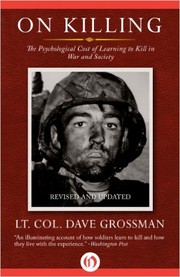Check nearby libraries
Buy this book

The twentieth century, with its bloody world wars, revolutions, and genocides accounting for hundreds of millions dead, would seem to prove that human beings are incredibly vicious predators and that killing is as natural as eating. But Lieutenant Colonel Dave Grossman, a psychologist and U.S. Army Ranger, demonstrates this is not the case.
The good news, according to Grossman - drawing on dozens of interviews, first-person reports, and historic studies of combat, ranging from Frederick the Great's battles in the eighteenth century through Vietnam - is that the vast majority of soldiers are loath to kill. In World War II, for instance, only 15 to 25 percent of combat infantry were willing to fire their rifles.
The provocative news is that modern armies, using Pavlovian and operant conditioning, have learned how to overcome this reluctance. In Korea about 50 percent of combat infantry were willing to shoot, and in Vietnam the figure rose to over 90 percent. The bad news is that by conditioning soldiers to overcome their instinctive loathing of killing, we have drastically increased post-combat stress - witness the devastated psychological state of our Vietnam vets as compared with those from earlier wars.
And the truly terrible news is that contemporary civilian society, particularly the media, replicates the army's conditioning techniques and - according to Grossman's controversial thesis - is responsible for our rising rates of murder and violence, particularly among the young.
In the explosive last section of the book, he argues that high-body-count movies, television violence (both news and entertainment), and interactive point-and-shoot video games are dangerously similar to the training programs that dehumanize the enemy, desensitize soldiers to the psychological ramifications of killing, and make pulling the trigger an automatic response.
Check nearby libraries
Buy this book

Previews available in: English
Subjects
Combat, Homicide, Military Psychology, Psychological aspects, Psychological aspects of Combat, Psychological aspects of Homicide, Psychological aspects of Violence, Psychology, Military, Social aspects, Social aspects of Violence, Violence, Psychology, Tötung, War, Krieg, Militärpsychologie, Armed Conflicts, Psychologie, Fremder Feind, Mord, War and society, Violence, psychological aspects, Psychological warfare, Murder, War, psychological aspects, Psychology, militaryShowing 2 featured editions. View all 20 editions?
| Edition | Availability |
|---|---|
|
1
On killing: the psychological cost of learning to kill in war and society
2009, Little, Brown and Co.
in English
- Rev. ed.
0316040932 9780316040938
|
zzzz
Libraries near you:
WorldCat
|
|
2
On killing: the psychological cost of learning to kill in war and society
1996, Little, Brown
in English
- 1st pbk. ed.
0316330116 9780316330114
|
aaaa
Libraries near you:
WorldCat
|
Book Details
Table of Contents
Edition Notes
Originally published: 1995.
"Back Bay books."
Includes bibliographical references (p. [348]-352) and index.
Classifications
The Physical Object
ID Numbers
Source records
Internet Archive item recordLibrary of Congress MARC record
Promise Item
Better World Books record
marc_nuls MARC record
marc_columbia MARC record
Work Description
The good news is that most soldiers are loath to kill. But armies have developed sophisticated ways of overcoming this instinctive aversion. And contemporary civilian society, particularly the media, replicates the army's conditioning techniques, and, according to Lt. Col. Dave Grossman's thesis, is responsible for our rising rate of murder among the young. Upon its initial publication, On Killing was hailed as a landmark study of the techniques the military uses to overcome the powerful reluctance to kill, of how killing affects soldiers, and of the societal implications of escalating violence. Now, Grossman has updated this classic work to include information on 21st-century military conflicts, recent trends in crime, suicide bombings, school shootings, and more. - Publisher.
Excerpts
Links outside Open Library
Community Reviews (0)
Feedback?History
- Created July 8, 2011
- 12 revisions
Wikipedia citation
×CloseCopy and paste this code into your Wikipedia page. Need help?
| July 18, 2024 | Edited by MARC Bot | import existing book |
| April 4, 2024 | Edited by OL-00 | Edited without comment. |
| March 7, 2023 | Edited by MARC Bot | import existing book |
| December 17, 2022 | Edited by ImportBot | import existing book |
| July 8, 2011 | Created by ImportBot | Imported from Internet Archive item record |













